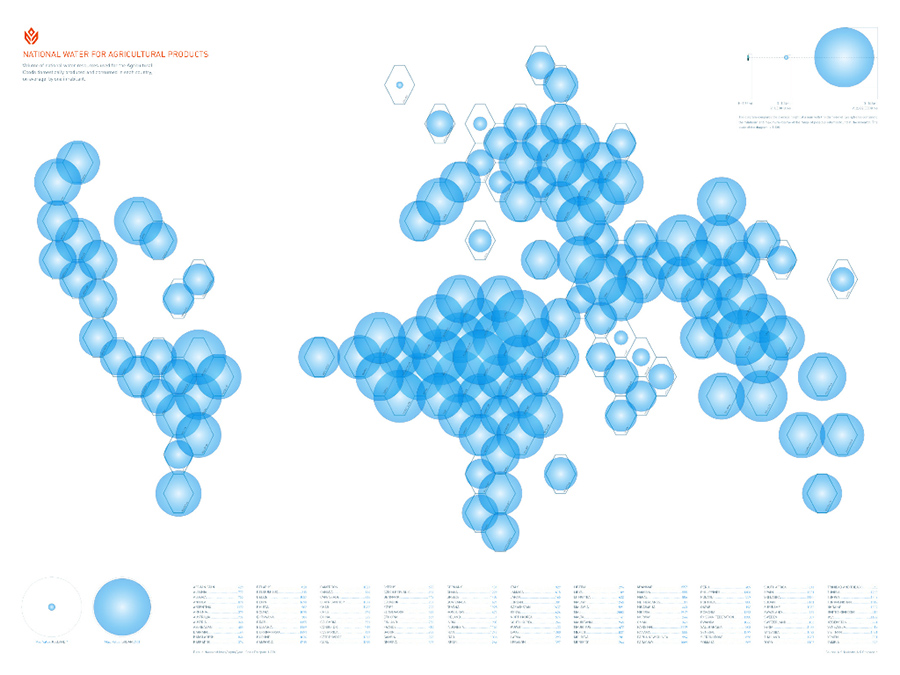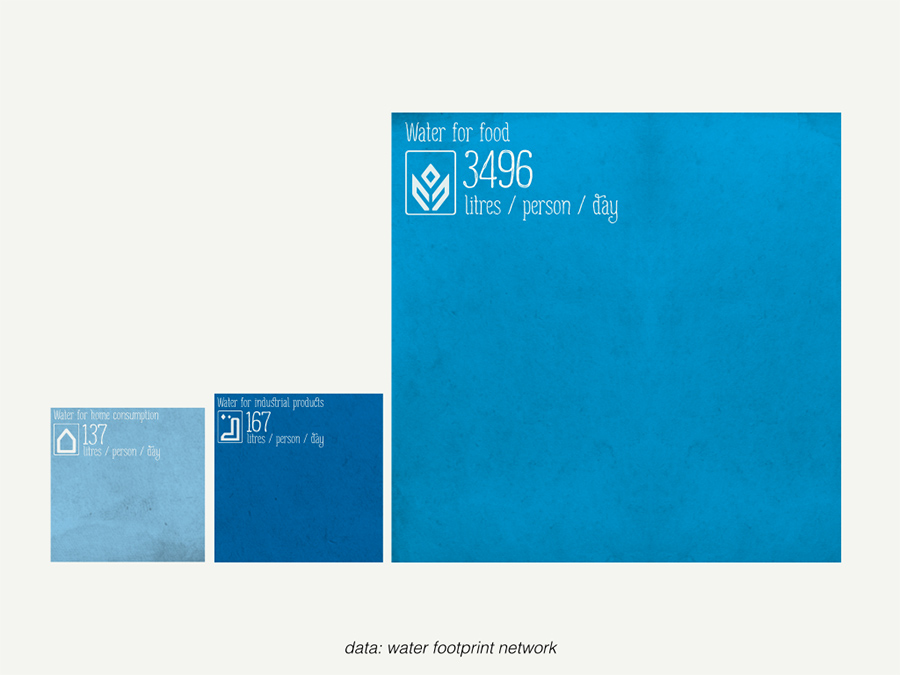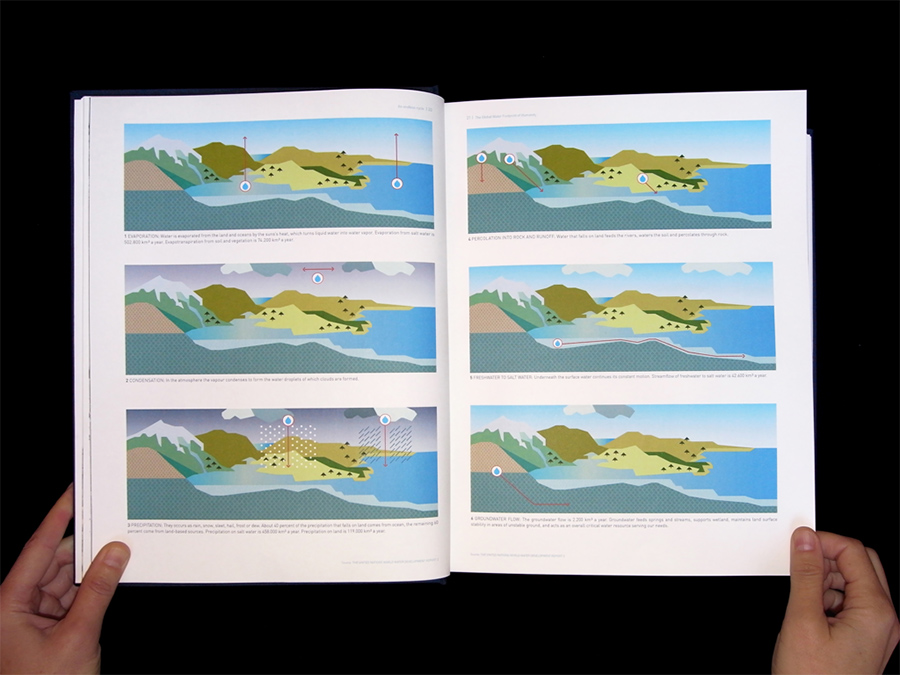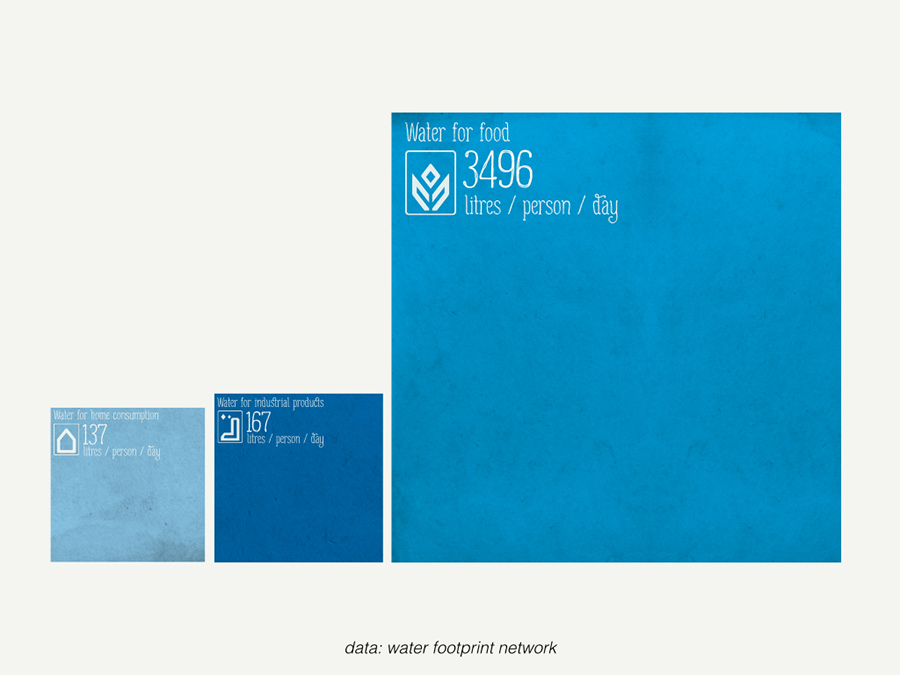Angela Morelli — A Story About Telling Stories
Angela Morelli
Central Saint Martins, University of the Arts, UK
This is an edited transcript of Angela Morelli’s presentation at Initiating Change by Design (ICD) Symposium, April 23rd 2014. Website: https://icd2014.wordpress.com/symposium/
Listen to audio version
Angela Morelli presentation – Initiating Change by Design (ICD) Symposium 2014
Abstract
Five years ago, Angela fell in love with the concept of virtual water. That concept took her on an amazing journey that led to major discoveries: our hidden demands on water, the power of information design and the importance of communicating science. In this presentation, Angela shares her professional journey through the fascination for water science explained by visual narratives. She tells about the struggle and joy, the conflicts and mediations, the wonder and uncertainty in discovering, understanding and visualizing the invisible data of our everyday water consumption.
With scientific knowledge such as water footprint, virtual water, climate change and sustainable consumption, the design of understanding and effective communication is vital in order to support action – but it is not sufficient. It is not sufficient because action and change result from a complex process in which not only cognition but also emotions play a major role.
ANGELA MORELLI: I guess the first thing to say is that seven years ago, I ventured into the world of communicating science, and I was trying to bridge the world of design and the world of science. That led to lots of identity crises! I have a background in engineering, but soon after my degree in engineering, I took an MA in Industrial Design. I worked as an industrial designer for some years with a focus on designing for better experiences. We used to redesign ugly looking machines for people working in factories, making them beautiful, functional and user-friendly. Nobody was mentioning the words ‘human-centred’ approach but that is what we were doing.
At the same time, I started to experience the power of communication design, and that’s why I moved to London and I did a two-year MA in Communication design at Central St Martins where I specialised in information design. Today I divide my time between my self-initiated projects and the work at the Norwegian Knowledge Centre for Health Services in Oslo, where we design information for patients, policy makers, and clinicians. We work on very interesting challenges. We don’t have any other option but co-working with our users by understanding them.
Today I would like to share with you three things that I’ve learned in the past seven years.
First is the value of content. As an information designer collaborating with scientists, one of the most important things I have learned is the value of ‘content’. I have learned that mastering the content with the guidance of scientists and experts is a crucial thing. Without a dialogue with the scientists, communicating science is a risky thing because we can easily focus on myths rather than truths, and communicate messages that may confuse or mislead.
The advantage of working with scientists on a daily basis is that you have the opportunity to dig into the content in an extraordinary way, because the dialogue never stops. That dialogue allows you to understand how to choose the most appropriate narrative and how to achieve a good balance between words and images. I experienced the value of that dialogue pretty soon when I decided to deal with water science during my Masters in London. I spent 12 months on a self-initiated project called the Global Water Footprint of Humanity. At that time I was not interested in information design per se, I was more interested in trying to communicate something that shocked me when I discovered it: the world is thirsty because it is hungry.
National Water for Food – The Global Water Footprint of Humanity: The Maps | Design: Angela Morelli | Data: http://www.waterfootprint.org
National Water for Food – The Global Water Footprint of Humanity: The Book | Design: Angela Morelli | Data: http://www.waterfootprint.org
National Water for Food – The Global Water Footprint of Humanity: The Book | Design: Angela Morelli | Data: http://www.waterfootprint.org
For years I had been bombarded with the myth of the water crisis linked to having a bath or brushing your teeth. But now scientists were telling us that the real problem is what we eat and how we produce what we eat, how we trade and how much we waste. In fact, 90 percent of our water use is due to the production of the food we eat and waste.
One hundred and thirty seven (137) litres is the average amount of water used per capita, per day, by you and me, for drinking, cleaning, and washing. This is the water that runs through our hands, the water we can see. The problem is that there are two invisible parts. The first is the water we use to produce industrial products such as paper, cotton, and clothes. This amounts to 167 litres per capita, per day. But the second invisible part is the big elephant in the room, and it is the water used on average to produce the food we consume, which amounts to 3496 litres per capita per day.
Ninety two percent of water-use is for food production and that was the main focus of my message. In the past seven years I experienced the power of communicating the same message but just in very different ways.
Global average water consumption per capita | Design: Angela Morelli | Data: http://www.waterfootprint.org
The second thing to share is the value of stories. Since the end of the MA project, I decided it would be a good idea to disseminate the water footprint research. I realised that people were interested not only in the message I was communicating, but also in the way I was communicating the message to the point that I ended up being invited on national TV in Italy and the invitation sounded like: As long as you can entertain with your info graphics you can talk about anything you want. And I talked about water. I experienced the power of reaching one million people in six minutes and I have learned so much more about communication. That experience reminded me that content, knowledge, and information are not the only important things. The story and narrative that carry the message can be even more important.
Talk after talk I started thinking about the way I was communicating my message on stage, and about how I could make a similar impact without being on stage through an online piece. I started thinking about ways of telling stories to explain a problem with data in a way that could be informative, but also engaging. I tried to translate my talks into what I call an info-graphic story. (http://www.angelamorelli.com/water)
I’m currently working on a new piece that is on food waste. (http://www.foodisforeating.org)
Richard Saul Wurman, an author, a great thinker and the founder of TED says in ‘Information Anxiety’ (1990):
Stories permit information to be imprinted into memory, they encourage the application of information… that is what gives it meaning.
I got more and more interested not just in how to tell stories with data, but in why stories can be so powerful. So why, what is that thing that makes us like stories? Is there a physiological, a cognitive reason? And also, can we enhance understanding through stories? I don’t know if you know the radio serial ‘Radio Lab’? It’s a science podcast and some months ago I was listening to an episode called ‘Placebo’. The two hosts Robert and Jed were talking to each other, and Robert says to Jed, ‘I will tell you a story about telling stories’, and this is the story.
It is a story about a guy who is the father of the placebo effect. A German guy named Henri Beecher. He served as a doctor during World War II and finds himself in the great battle of Anzio when the Americans landed in Nazi Europe. Soldiers were being killed and some were being wounded and Henri Beecher’s job was to treat the soldiers. The treatment at that time for pain, as it is still nowadays, was morphine. There was a problem. Beecher’s division became low on supplies of morphine and he had to figure out which soldiers needed it the most. Beecher is talking to the soldiers and he is asking them how much pain they are actually having. He would go there and ask: ‘soldier, as you lay there, are you having any pain?’ Now imagine you are a soldier, you have a wound in your guts and you haven’t had any morphine for seven hours, what would you say? Ok you would probably say, ‘give me some morphine, I am in pain’. The striking fact was that 75% were saying no, ‘No doc, I am ok, I do not need any morphine right now’, three quarters of them said that. Now doctor Beecher knew a lot about pain, he ran a clinic in Boston, where he would see people with wound injuries, gut injuries, more or less the same kind of injuries he saw on the battlefield, but back in Boston, those injuries really hurt. And he had soldiers desperately asking for more morphine. For some strange reason the intensity of the pain associated with being shot was lower in the battlefield than in civilian life. What can explain that?
Scientists say that we [as living people] are the unfolding of an ongoing narrative, and one of the scientists is Charles Fernyhough. Robert and Jed paraphrase from Fernyhough’s book ‘A thousand days of wonder’ (2008), saying we have an inner flow in our head. Thinking itself is a thread of inner speech, a verbal flow, plus the amount of things we do not manage to put into language such as feelings, emotions. We embody an ongoing narrative.
Therefore we embody an ongoing narrative, basically we are stories, we think in stories, we understand through stories and that’s why they are so crucial. It’s something we carry in our genes. Science also shows us that the stories we tell ourselves are not always the result of a rational process.
That is when the third thing I want to share enters my story: the value of meaning. Some years ago I thought that clarity and accuracy were enough in order to connect with people, and I thought that good design was enough, but I was wrong. I have learned from science that understanding is a complex process that involves not only logical reasoning but also the emotions. The complexity of human nature can aid or undermine the process of understanding, even when there is scientific consensus about the information we are communicating.
It is not just about the message we want to get across but about how the message is perceived and experienced by the audience. It’s not just about storytelling, but also about ‘story-listening’. There is a lot of talking about storytelling in data visualisation, but the word storytelling in its own construction is teller centric, whereas the word ‘story-listening’ is listener centric. I find that fascinating because we suddenly switch perspective and we focus on what the listener perceives, his/her emotions, reactions, we build the story around them. Starting with our listeners is such a good practice – it will help us figure out their mental journey and help guide us through the process of designing the story we want them to understand. If understanding and action are our goals, the story we tell – whether it is based on words or numbers, sounds or images – should be a journey in the mind of our listeners, a journey that includes all the necessary steps to achieve understanding and facilitate action, an experience we build by orchestrating the balance of perception and cognition, feelings and emotions.
Scientists tell us that the human ability for understanding does not rely purely on logical reasoning but also on emotional mechanisms. Professor Daniel Kahneman is one of those scientists. Nobel laureate in behavioural economics he offers us some incredible insights about the way we think and how rational and irrational we are. You might have to read ‘Thinking fast and slow’ (2011)… I think it should be compulsory in design communication courses. Kahneman tells us that human ability for understanding does not rely just on logical reasoning but on emotional mechanism. He tells us that we understand the world by employing two different modes of thought, which he classifies as ‘System 1’ and ‘System 2’.
System 1 produces the kind of actions that we call automatic and the kind of thoughts that we call intuitive, it produces the actions that allows us to avoid an obstacle when driving, or evoke an emotion if I show you a picture of your mother for example. So System 1 is the fast system.
System 2 produces the kind of actions that require mental work and the thoughts that we call intentional, so it produces the kind of actions that allow us to read a map or a form. System 2 is the slow system.
Kahneman’s research tell us that when we think about ourselves, we identify with System 2, the conscious reasoning self that has beliefs, makes choices and decides what to think about and what to do. But what happens instead is that it is the instinctive System 1 that guides us. It is System 1, he says, that provides the impressions that turn into belief. It is System 1 that gives a tacit interpretation of what is happening around us and of the reality around us. System 1 is the source of the impulses that often become our choices and our actions. We believe in system 1 and in what it tells us. System 1 is a storytelling system. It gives meaning to reality through stories and produces stories that make sense to us and are coherent.
But with System 1, this coherence is not logical coherence but associative and emotional coherence.
Associative coherence is a form of coherence that depends on how well the information we receive fits into our network of ideas and beliefs. It depends on the meaning we give to that information. Kahneman warns us that when we communicate we should never forget to speak to the System 1 of our audiences and we should remember that system 1 is bound more by the coherence of the story than by the scientific evidence behind it. In other words, communicating evidence is necessary but not sufficient in order for an audience to understand, accept, and embrace the information we communicate.
We need to know where the audience is and how to connect to them, and we need to come up not with a narrative that we think is good for us, but with a narrative that is good for them. And that narrative is incredibly dependent on the social group our audience belongs to. If the information they receive threatens their connection to the group they belong to, they are likely to reject that information. That is, it does not matter if the story is well told and the information well designed?
Ed Gillespie is the co-founder of Futerra. I don’t know if you know Futerra? It is one of the world’s only communication consultancies that specialise in sustainable development and corporate social responsibility. He suggests bearing in mind four ‘S’ when they talk about sustainability campaigns: ‘Story, Sizzle, Salience and Social Proof’. I just want to share with you two short chunks of Ed’s talk that you can find on-line in the stories on their website. (Listen @ http://www.futerra.co.uk/story – go=stories-sizzle-salience-and-social-proof-6005).
The reason why I shared this with you is because I think it’s extremely relevant for what we will be discussing tomorrow. It’s not just about the facts and the information we communicate and how well we design our messages. Connecting with people is also very important because it’s about trying to understand what they think and how they perceive the information. I was very happy this morning to hear in the welcoming speech two points: sharing knowledge and common sense. In the book, ‘Visualising information for advocacy’ (2013), one of my favourite books on information design, we read:
… influence can be understood as the ability…to harness care (p. 19).
Whether the audience is made up of policy makers or a community, your message has to generate enough care in these people to lead to a shift in opinions or move to actions.
So before telling people what they have to do, we have to build a sense of care in them and we have to design how to harness care. In that way they can actually take care of the message we are communicating.
ABBY MELLICK LOPES: Thanks Angela, comments or questions?
SPEAKER: I’d be interested to know your opinion on any of the Michael Gartenberg research on cognitive processing and emotions which I think is similar to ‘Thinking fast and slow’ with the idea that every idea that we have ever encountered has some emotional reaction, which I think is what he’s saying?
ANGELA MORELLI: I’m not familiar with that model, but what Professor Kahneman says makes a lot of sense to me. It’s very basic and it is scientific knowledge. It’s also very important because when you get engaged with people and you talk to policy makers, it’s very hard to talk about emotions. Being backed by science in the idea that emotions and feelings are important, in the way you have to engage citizens, can be extremely powerful. Especially in the field I’m working in, medical science, we did a lot with policy makers, clinicians and patients. Sometimes we refer to Professor Kahneman because there are loads of very important points about decision making for example. We think that on a policy making level, decisions are the result of logical reasoning whereas in many, many cases the result can be biases and not good information – it’s very important to share this kind of knowledge; both in design but also when you are trying to make others understand what really counts, when you are trying to communicate something important.
SPEAKER: It’s great to see your work on water, we’re in the thirstiest continent on the planet and yet certainly in Australia we consume per person a huge amount more than say in Europe. The fact that you’re measuring hidden water is wonderful. What impact is it having then? Certainly I have seen very few bodies interested in this, particularly Sydney Water for instance whose mission is to promote the consumption of water. Yet it doesn’t really get much traction where it really should. So if information design can help us as a potential consumer, but we are not really – it’s not really having an impact where it should. I was just going to ask how to wrestle with that?
ANGELA MORELLI: Yes that’s something I sort of like – it’s the struggle that I always go through any time I have to decide or undertake a new self-initiated project for example. I haven’t measured the impact of the water info-graphic I did, though I had massive feedback from people, I have had a few people telling me that they became vegetarian after seeing that. But I haven’t collected like hundreds or thousands of stories and I haven’t tested with a randomised trial, which I might do with the second one. To go back to what you say, I think that it’s very hard as an information designer you have to be very conscious about why you are doing what you are doing, so in my case for example I am very consciously trying to explain things to people without asking them to act.
I have always said that understanding precedes action and change. I’m not entirely sure about that, it might work sometimes but I think that if you want people to change, you have to aim at behavioural change which might be completely different than explaining things to people. I mean it’s very clear to me that it’s not by explaining things to people that they might change a behaviour.
My work is targeting consumers or general audiences, not policymakers. One of the thoughts that I had in the past years was how would it be to use information design or design skills and target policymakers because we assume that policy makers understand knowledge. My experience for example, in medical information, shows me that it’s not the case. What we do with policymakers is try to communicate medical information to them, we assume they always understand, and they don’t. And when they don’t, of course, they don’t manage to make good decisions – for instance, supporting a treatment (b) is better than supporting a treatment (a). When I started talking to people about water footprints, seven years ago, audiences were shocked. People were completely blown away. I think that on a policy making level as designers we need to be able to venture into areas that can allow researchers and scientists to talk to policy makers through different tools. Such as design tools that can support understanding, I believe that that can have impact on better decisions.
References
Fernyhough, C. (2008). A thousand days of wonder. London: Granta.
Kahneman, D. (2011). Thinking, fast and slow. New York: Farrar, Straus and Giroux.
Tactical Technology Collective. (2013). Visualising information for advocacy. The Netherlands: Tactical Technology Collective.
Wurman, R.S. (1990). Information Anxiety: What to do when information doesn’t tell you what you need to know. New York: Bantam.
About the speaker
Angela Morelli is an Italian information designer based in Norway. She is an associate lecturer at Central St Martins in London, and at the Oslo National Academy of Art and Design. She gained her MA in Communication Design from Central St Martins where she specialised in information design. She also has a degree in engineering from Milano Polytechnic and an MA in Industrial Design. She advocates for environmental issues through the use of information-graphic stories and collaborates with scientists at the Norwegian Knowledge Centre for Health Services in Oslo with the aim of communicating medical information to doctors, patients and policy makers. She serves as an ambassador for Virtual Water and Water Footprint research and was named Young Global Leader by the World Economic Forum.
Email: an.morelli@me.com





